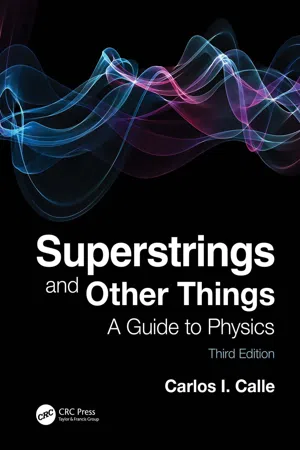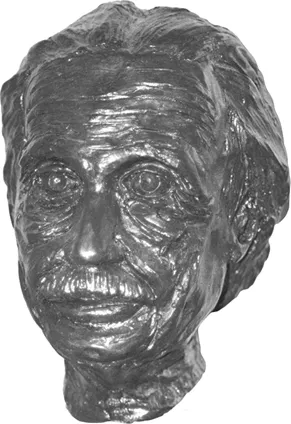
This is a test
- 454 pages
- English
- ePUB (mobile friendly)
- Available on iOS & Android
eBook - ePub
Book details
Book preview
Table of contents
Citations
About This Book
Continuing to take readers on a uniquely accessible journey through physics, Superstrings and Other Things: A Guide to Physics, Third Edition, explains the basic concepts of motion, energy, and gravity, right up to the latest theories about the structure of matter, the origin and structure of the universe, and the beginning of time. Fully updated throughout, this book explores major historical discoveries and the scientists behind them. In addition, this comprehensive text details the breathtaking frontiers of physics being explored today. Offering nonscience students access to the highest peaks of physics, Dr. Calle translates concepts so they can be appreciated by those with willing curiosity and imagination.
Features
-
- Provides up-to-date coverage of modern physics,
-
- Offers nonscience students and laymen access to the highest peaks of physics,
-
- Showcases modern applications of physics in our everyday world.
Frequently asked questions
At the moment all of our mobile-responsive ePub books are available to download via the app. Most of our PDFs are also available to download and we're working on making the final remaining ones downloadable now. Learn more here.
Both plans give you full access to the library and all of Perlego’s features. The only differences are the price and subscription period: With the annual plan you’ll save around 30% compared to 12 months on the monthly plan.
We are an online textbook subscription service, where you can get access to an entire online library for less than the price of a single book per month. With over 1 million books across 1000+ topics, we’ve got you covered! Learn more here.
Look out for the read-aloud symbol on your next book to see if you can listen to it. The read-aloud tool reads text aloud for you, highlighting the text as it is being read. You can pause it, speed it up and slow it down. Learn more here.
Yes, you can access Superstrings and Other Things by Carlos I. Calle in PDF and/or ePUB format, as well as other popular books in History & Military & Maritime History. We have over one million books available in our catalogue for you to explore.
Part I
Introductory Concepts
1 Physics
The Fundamental Science
What is Physics?
Physics deals with the way the universe works at the most fundamental level. The same basic laws apply to the motion of a falling snowflake, the eruption of a volcano, the explosion of a distant star, the flight of a butterfly, or the formation of the early universe (Figure 1.1).

FIGURE 1.1 The laws of physics apply to (a) a falling snowflake. (Courtesy of Jefunne, Shutterstock.com). (b) The explosion of a star and (c) the eruption of a volcano. (Courtesy of NASA.)
It is not difficult to imagine that some 30,000 years ago during a cold, dark spring night, a young child moved perhaps by the pristine beauty of the starry sky, looked at his mother, and, in a language incomprehensible to any of us today, asked: “Mother, who made the world?”
To wonder how things come about is, of course, a universal human quality. As near as we can tell, human beings have been preoccupied with the origin and nature of the world for as long as we have been human. Each of us echoes the words of the great Austrian physicist Erwin Schrödinger, “I know not whence I came nor whither I go nor who I am,” and seeks the answers.
Here lies the excitement that this quest for answers brings to our minds. Today, scientists have been able to pierce a few of the veils that cloud the fundamental questions that whisper in our minds with a new and wonderful way of thinking that is firmly anchored in the works of Galileo, Newton, Einstein, Bohr, Schrödinger, Heisenberg, Dirac, and many others whom we shall meet in our journey into the world of physics.
Physics, then, attempts to describe the way the universe works at the most basic level. Although it deals with a great variety of phenomena of nature, physics strives for explanations with as few laws as possible. Let us, through a few examples, taste some of the flavors of physics.
We all know that if we drop a sugar cube in water, the sugar dissolves in the water, and as a result, the water becomes thicker, denser—that is, more viscous. We, however, are not likely to pay a great deal of attention to this well-known phenomenon.
One year after graduating from college, Albert Einstein (Figure 1.2) considered the same phenomenon and did pay attention to it. Owing to his rebellious character, Einstein had been unable to find a university position as he had wanted, and was supporting himself with temporary jobs as a tutor or a substitute teacher. While substituting for a mathematics teacher in the Technical School in Winterthur, near Zurich, from May to July 1901, Einstein started thinking about the sweetened water problem. “The idea … may well have come to Einstein as he was having tea,” writes a former collaborator of Einstein.

FIGURE 1.2 Albert Einstein. (Terracotta sculpture by the author.)
Einstein simplified the problem by considering the sugar molecules to be small hard bodies swimming in a structureless fluid. This simplification allowed him to make calculations that had been impossible until then that explained how the sugar molecules would diffuse in the water, making the liquid more viscous.
This was not sufficient for the 22-year-old scientist. He looked up actual values of viscosities of different solutions of sugar in water, put these numbers into his theory, and obtained from his equations the size of sugar molecules! He also found a value for the number of molecules in a certain mass of any substance (Avogadro’s number). With this number, he could calculate the mass of any atom. In 1906, Einstein wrote a scientific paper about his theory, entitled A New Determination of Molecular Dimensions.
On the heels of this paper, Einstein submitted for publication another important paper on molecular motion, in which he explained the erratic, zigzag motion of individual particles of smoke. Again, always seeking the fundamental, Einstein was able to show that this chaotic motion gives direct evidence of the existence of molecules and atoms. “My main aim,” he wrote later, “was to find facts that would guarantee as far as possible the existence of atoms of definite finite size.”
Almost a century earlier, Joseph von Fraunhöfer, an illustrious German physicist, discovered that the apparent continuity of the sun’s spectrum is actually an illusion. This seemingly unrelated discovery was actually the beginning of the long and tortuous road toward the understanding of the atom. Fraunhöfer, the 11th and youngest child of a glazier, became apprenticed to a glassmaker at the age of 12. Three years later, a freak accident turned the young lad’s life around; the rickety boarding house he was living in collapsed, and he was the only survivor. Maximilian I, the elector of Bavaria, rushed to the scene and took pity on the poor boy. He gave the young man 18 ducats. With this small capital, Fraunhöfer was able to buy books on optics and a few machines with which he started his own glass-working shop. While testing high-quality prisms, Fraunhöfer found that the spectrum formed by sunlight after it passed through one of his prisms was missing some colors; it was crossed by numerous minuscule black lines, as shown in Figure 1.3. Fraunhöfer, intrigued, continued studying the phenomenon, measuring the position of several hundred lines. He placed a prism behind the eyepiece of a telescope and discovered that the dark lines in the spectrum formed by the light from the stars did not have quite the same pattern as that of sunlight. He later discovered that looking at the light from a hot gas through a prism produced a set of bright lines similar to the pattern of dark lines in the solar spectrum.

FIGURE 1.3 The solar spectrum with some of the dark lines discovered by Fraunhöfer.
Today, we know that the gaps in the spectrum that Fraunhöfer discovered are a manifestation of the interaction between light and matter. The missing colors in the spectrum are determined by the atoms that make up the body emitting the light.
In the spring of 1925, a 24-year-old physicist named Werner Heisenberg, suffering from severe hay fever, decided to take a 2-week vacation on a small island in the North Sea, away from the flowers and the pollen. During the previous year, Heisenberg had been trying to understand this interaction between light and matter, looking for a mathematical expression for the lines in the spectrum. He had decided that the problem of the relationship between these lines and the atoms could be analyzed in a simple manner by considering the atom as if it were an oscillating pendulum. In the peace and tranquility of the island, Heisenberg was able to work out his solution, inventing the mechanics of the atom. Heisenberg’s new theory turned out to be extremely powerful, reaching beyond the original purpose of obtaining a mathematical expression for the spectral lines.
In 1984, this idea of thinking about the atom as oscillations took a new turn. John Schwarz of the California Institute of Technology and Michael B. Green of the University of London proposed that the fundamental particles that make up the atom are actually oscillating strings. The different particles that scientists detect are actually different types or modes of oscillation of these strings, much like the different ways in which a guitar string vibrates. This clever idea, which was incredibly difficult to implement, produced a theory of enormous beauty and power, which explains and solves many of the difficulties that previous theories had encountered. The current version of the theory, called superstring theory—which we will study in more detail in Chapter 26—promises to unify all of physics and help us understand the first moments in the life of the universe. Still far from comple...
Table of contents
- Cover
- Half Title
- Title Page
- Copyright Page
- Dedication
- Table of Contents
- Preface
- Acknowledgments
- Author
- Part I Introductory Concepts
- Part II The Laws of Mechanics
- Part III The Structure of Matter
- Part IV Thermodynamics
- Part V Electricity and Magnetism
- Part VI Waves
- Part VII Modern Physics
- Appendix A: Powers of Ten
- Appendix B: The Elements
- Appendix C: Nobel Prize Winners in Physics
- Appendix D: Physics Timeline
- Glossary
- Index